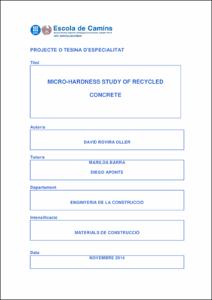Mostra el registre d'ítem simple
Estudio de la microdureza de hormigones con áridos reciclados
| dc.contributor | Barra Bizinotto, Marilda |
| dc.contributor.author | Rovira Oller, David |
| dc.contributor.other | Universitat Politècnica de Catalunya. Departament d'Enginyeria de la Construcció |
| dc.date.accessioned | 2015-01-13T16:47:35Z |
| dc.date.available | 2015-01-13T16:47:35Z |
| dc.date.issued | 2014-11-26 |
| dc.identifier.uri | http://hdl.handle.net/2099.1/24513 |
| dc.description.abstract | [ANGLÈS] In the present thesis, a micro - structural behavior study of concretes with recycled aggregates, coming from the construction and demolition wastes, is carried out. The crescent importance of the natural environment, the resources management and the polluting emissions; has made clear the need of giving a longer life cycle to our resources, especially in construction. To do that, one plausible solution , is to change the natural aggregates to recycled aggregates. Nowadays, the actual Spanish legislation only allows the aggregate substitution up to 20%; a very limiting number that explains the ignorance, still living, about the recycled concretes. The pu rpose of this thesis is to get deep in the micro - structural behavior research of these concretes that contains recycled aggregates in comparison to the conventional concretes. To do so, the interfacial transition zone (ITZ) between the aggregates and the b ulk paste is examined. At the same time the different phases of the concrete are characterized. The ITZ is considered as the more vulnerable zone of the concrete, the weakest point of the conglomerate union, and then, the first zone to break under applied loads. The ITZ behavior is analyzed in terms of hardness by the Vickers Hardness test. The analysis is done for large concrete typologies with different w/c ratios, different percentages substitution of recycled aggregates and even different dosages method s. The results are subjected to a comparative analysis and the particularities of the heterogeneity on the re cycled aggregates are commented; as well as the micro - structural phenomenon that take place in the micro - hardness test as, for example, the ISE (I ndentation Size Effect). Finally, it has been found a relation between the micro - hardness of the cement paste and the compression strength of concrete. Though, the same relation in the ITZ does not seem to be clear. On the same line, it has shown a relatio n between the elastic module and the micro - hardness but it is also a bit unclear; it seems that the aggregate‘s stiffness is dominant in this relation, more than the cement paste or the ITZ could be. |
| dc.description.abstract | [CASTELLÀ] En la presente tesis se lleva a cabo un estudio del comportamiento micro - estructural de los hormigones con presencia de áridos reciclados provenientes de los residuos de construcción y demolición (RCD). El nivel de importancia que ha tomado estos últimos años la protección del medio ambiente, la gestión de los recursos y las emisiones de contaminantes; han hecho patente la necesidad de dar una vida útil más longeva a los recursos, sobretodo en construcción. Para ello, una solución plausible, es la substitución de los áridos naturales por áridos reciclados. Actualmente la legislación española vigente solo permite la substituci ón de hasta un 20%; una cifra muy limitante fru to de la necesidad de mantener unos límites de seguridad que aseguren las propiedades del hormigón. El propósito de esta tesis es ahondar en la investigación del comportamiento de los hormigones con áridos reciclados en comparación con los hormigones convencionales a nivel microscópico. Para ello, se investiga la zona de inter - fase (ITZ) entre los árido s y la pasta de cemento, y se caracterizan las distintas fases del hormigón . La ITZ está considerada como la zona más vulnerable del hormigón, el punto más débil de la unión del conglomerado, y por tanto la zona que cede en primer lugar ante las cargas. S e analiza el comportamiento de la ITZ en términos de dureza mediante el ensayo de Vickers para un amplio rango de hormigones con distintas relaciones a/c, distintos porcentajes de substitución por árido reciclado e incluso distintas tipologías de dosificac ión. Los resultados se someten a un análisis comparativo y se comentan las particularidades de heterogeneidad que presentan los áridos reciclados, así como los fenómenos micro - estructurales que ocurren en el ensayo de micro - dureza cómo el ISE (Indentation Size Effect). Por último se encuentra una relación entre la dureza de la pasta del hormigón y la resistencia del mismo a compresión. La misma relación analizada en la ITZ no resulta tan clara. También, y en la misma línea, se revela una relación entre el m ódulo elástico y la dureza, aunque no de forma clara; parece que la rigidez de los áridos es dominante en esta relación más que la pasta de cemento o la ITZ. |
| dc.language.iso | eng |
| dc.publisher | Universitat Politècnica de Catalunya |
| dc.rights | Attribution 3.0 Spain |
| dc.rights.uri | http://creativecommons.org/licenses/by/3.0/es/ |
| dc.subject | Àrees temàtiques de la UPC::Enginyeria civil::Materials i estructures::Materials i estructures de formigó |
| dc.subject.lcsh | Aggregate (Building materials) |
| dc.subject.other | recycled concrete |
| dc.subject.other | ITZ analysis |
| dc.subject.other | ISE |
| dc.subject.other | compressive strength |
| dc.subject.other | micro-hardness |
| dc.subject.other | Vickers Hardness test |
| dc.title | Estudio de la microdureza de hormigones con áridos reciclados |
| dc.type | Minor thesis |
| dc.subject.lemac | Indústria de la construcció -- Residus |
| dc.subject.lemac | Àrids (Materials de construcció) |
| dc.identifier.slug | PRISMA-95269 |
| dc.rights.access | Open Access |
| dc.date.updated | 2014-12-10T19:00:42Z |
| dc.audience.educationlevel | Estudis de primer/segon cicle |
| dc.audience.mediator | Escola Tècnica Superior d'Enginyers de Camins, Canals i Ports de Barcelona |
| dc.audience.degree | ENGINYERIA DE CAMINS, CANALS I PORTS (Pla 1995) |


